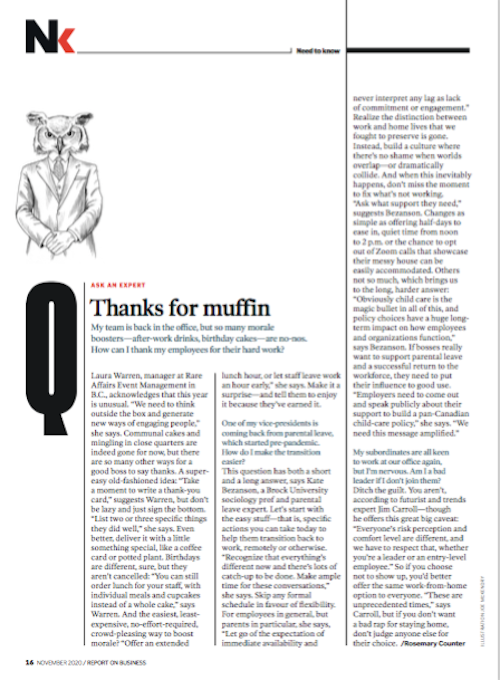Thanks for Muffin
Report on Business: Ask an Expert
My team is back in the office, but so many morale boosters—after-work drinks, birthday cakes—are no-nos. How can I thank my employees for their hard work?
Laura Warren, manager at Rare Affairs Event Management in B.C., acknowledges that this year is unusual. “We need to think outside the box and generate new ways of engaging people,” she says. Communal cakes and mingling in close quarters are indeed gone for now, but there are so many other ways for a good boss to say thanks. A super-easy old-fashioned idea: “Take a moment to write a thank-you card,” suggests Warren, but don’t be lazy and just sign the bottom. “List two or three specific things they did well,” she says. Even better, deliver it with a little something special, like a coffee card or potted plant. Birthdays are different, sure, but they aren’t cancelled: “You can still order lunch for your staff, with individual meals and cupcakes instead of a whole cake,” says Warren. And the easiest, least-expensive, no-effort-required, crowd-pleasing way to boost morale? “Offer an extended lunch hour, or let staff leave work an hour early,” she says. Make it a surprise—and tell them to enjoy it because they’ve earned it.
One of my vice-presidents is coming back from parental leave, which started pre-pandemic. How do I make the transition easier?
This question has both a short and a long answer, says Kate Bezanson, a Brock University sociology prof and parental leave expert. Let’s start with the easy stuff—that is, specific actions you can take today to help them transition back to work, remotely or otherwise. “Recognize that everything’s different now and there’s lots of catch-up to be done. Make ample time for these conversations,” she says. Skip any formal schedule in favour of flexibility. For employees in general, but parents in particular, she says, “Let go of the expectation of immediate availability and never interpret any lag as lack of commitment or engagement.” Realize the distinction between work and home lives that we fought to preserve is gone. Instead, build a culture where there’s no shame when worlds overlap—or dramatically collide. And when this inevitably happens, don’t miss the moment to fix what’s not working. “Ask what support they need,” suggests Bezanson. Changes as simple as offering half-days to ease in, quiet time from noon to 2 p.m. or the chance to opt out of Zoom calls that showcase their messy house can be easily accommodated. Others not so much, which brings us to the long, harder answer: “Obviously child care is the magic bullet in all of this, and policy choices have a huge long-term impact on how employees and organizations function,” says Bezanson. If bosses really want to support parental leave and a successful return to the workforce, they need to put their influence to good use. “Employers need to come out and speak publicly about their support to build a pan-Canadian child-care policy,” she says. “We need this message amplified.”
My subordinates are all keen to work at our office again, but I’m nervous. Am I a bad leader if I don’t join them?
Ditch the guilt. You aren’t, according to futurist and trends expert Jim Carroll—though he offers this great big caveat: “Everyone’s risk perception and comfort level are different, and we have to respect that, whether you’re a leader or an entry-level employee.” So if you choose not to show up, you’d better offer the same work-from-home option to everyone. “These are unprecedented times,” says Carroll, but if you don’t want a bad rap for staying home, don’t judge anyone else for their choice.
